Satanic Leaf-tailed Geckos (Uroplatus phantasticus) are masterfully camouflaged reptiles that represent a unique evolutionary lineage within the family Gekkonidae, an order of scaled reptiles known as Squamata [1]. Endemic to the northern and central tropical forests of Madagascar, this species’s common name originates from its striking red eyes and horn-like head scales, which give it a “demonic” appearance [1]. With an average total length of 2.5 to 3.5 inches (6.4–9 cm), it is one of the smallest species in its genus, a trait that further enhances its ability to mimic decaying leaves and hide in plain sight [2, 4]. The species’s current conservation status is classified as Least Concern by the IUCN, though population numbers are decreasing due to persistent threats like habitat loss and illegal collection [2].
This comprehensive guide on Uroplatus phantasticus synthesizes key knowledge about its taxonomic hierarchy, physical and behavioral characteristics, and ecological importance. This analysis will delve into the distinct features that distinguish it from similar species and its crucial role as a bioindicator of forest health.
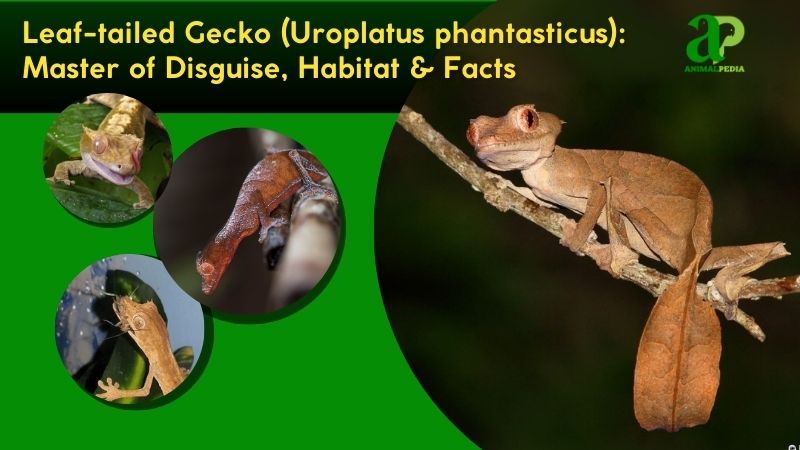
What Are Leaf-tailed Geckos?
The Satanic Leaf-tailed Gecko (Uroplatus phantasticus) is a fascinating arboreal reptile, native to Madagascar’s diverse tropical ecosystems, distinguished by its unique ability to perfectly mimic the appearance of a decaying leaf [1]. As a member of the class Reptilia and the order Squamata, it belongs to the family Gekkonidae, which is renowned for its diverse species of geckos [1]. While its most recognized appellation is the Satanic Leaf-tailed Gecko, a reference to its bold head scales and red eyes, it is also widely known as the Eyelash Leaf-tailed Gecko or Phantastic Leaf-tailed Gecko, names that highlight its distinct eyelash-like projections and extraordinary, imaginary-like appearance [1]. The genus name Uroplatus stems from the Greek words “ourá” (tail) and “platys” (flat), and its species epithet, phantasticus, is derived from Latin, signifying its fantastic or otherworldly form, a quality first noted by naturalist George Albert Boulenger in 1888 [1].
Taxonomically, there is an ongoing scientific debate regarding the relationship between U. phantasticus and its close relative, the Spearpoint Leaf-tailed Gecko (Uroplatus ebenaui), with some researchers arguing they are part of the same species complex [1]. This contention arises from observed overlaps in morphological traits, particularly tail length, though others maintain that U. phantasticus‘s more pronounced head and body spines distinguish it as a separate species, a subject that necessitates further genetic studies to resolve definitively [1]. Beyond its classification, what specific physical characteristics enable such a remarkable illusion, and how are these features distinct from other species? Let’s explore the incredible physical traits that make this gecko a master of disguise.

What Do Leaf-tailed Geckos Look Like?
The physical appearance of the Leaf-tailed Gecko is a testament to its evolutionary specialization for cryptic camouflage, allowing it to blend seamlessly into the forest understory of its native Madagascar [1]. This creature possesses a slender and flattened body, with fringed dermal flaps extending along the head, torso, and limbs to disrupt its silhouette and eliminate shadows when pressed against a surface [2, 4]. Its skin is a mottled tapestry of browns, grays, rust, and even hues of purple or orange, with intricate patterns that mimic the veins and imperfections of a decaying leaf [1]. This remarkable coloration and texture, combined with its unique body structure, forms the foundation of its disguise.
This Leaf-tailed gecko species exhibits five morphological features that further enhance its camouflage and survival. The most prominent are:
- Striking Red Eyes: Its large, lidless, and distinctive red eyes with vertical, elliptical pupils are a key feature [1]. These specialized pupils can constrict to a series of pinholes in bright light, allowing the gecko to function in both day and night conditions. Their nocturnal visual acuity is approximately 350 times better than humans in low light, which, combined with a potential for color vision at night, provides a crucial advantage for a nocturnal hunter.
- Intricate Head Structure: The triangular head is not merely a geometric shape but is intricately designed with horn-like scales above the eyes that resemble eyelashes. These “eyelash” projections serve a functional purpose by further breaking up the gecko’s outline, helping to obscure its profile and integrate it more completely with the surrounding foliage.
- A Startling Defensive Display: The gecko’s mouth has a bright red interior that is typically hidden. When threatened, the gecko will open its jaws in a sudden and surprising threat display, a behavior used to startle and deter potential predators. This startling flash of color, often accompanied by a distress call resembling a child’s scream, is a highly effective defense mechanism.
- Regenerative Teeth: Despite its small size, the gecko possesses a formidable array of 97 to 169 teeth in its jaws, which are small, sharp, and designed for grasping insect prey [1]. A remarkable feature of its dentition is that, like sharks, its teeth are replaced continuously throughout its life, ensuring a perpetual ability to grasp and secure its meals.
- A Camouflage-Enhancing Tail: The species is named for its most distinctive feature, a flattened, leaf-shaped tail that is often notched and tapered at the end. This structure not only perfectly mimics the appearance of a withered leaf but also serves a critical function in the gecko’s defense. The tail can be deliberately shed through autotomy to distract a predator, allowing the gecko to escape, and a new tail will eventually regenerate [2].
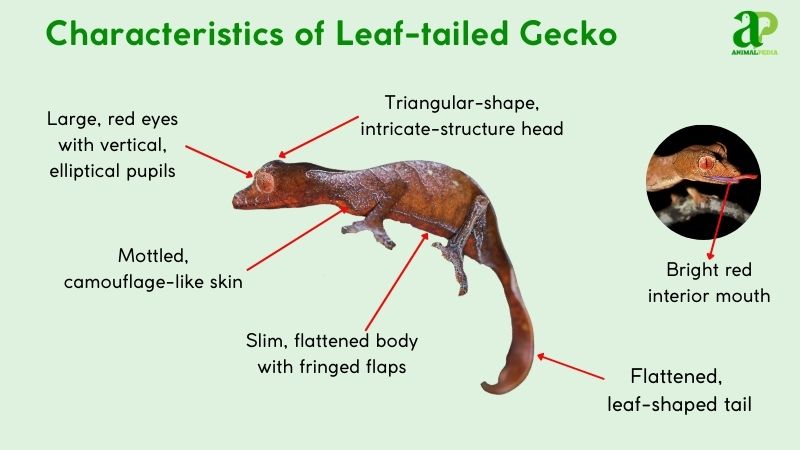
Sexual dimorphism is also evident, primarily in the tail structure, where males commonly possess more pronounced notches in their tails, a trait thought to be a form of camouflage enhancement and potentially a signal for mate recognition [2]. Females, while typically slightly larger, tend to lack these distinct tail notches, showing a subtle yet significant difference in physical appearance between the sexes. Curious about the gecko’s physical dimensions? The next section reveals exactly how small these remarkable reptiles are.
How Big Are Leaf-tailed Geckos?
The average adult Leaf-tailed Gecko typically measures between 2.5 to 3.5 inches (6.4–9 cm) from snout to vent, with the tail adding a similar length, placing them among the smallest members of their genus [1, 4]. This diminutive size is a crucial aspect of their camouflage. Hatchlings emerge at a mere 1 to 1.5 inches (2.5–3.8 cm), growing to adulthood in a few months. How do the sexes compare in size?
| Aspect | Male | Female |
| Length | 2.5–3.5 in | 2.5–3.5 in |
| Weight | up to 20 g | up to 20 g |
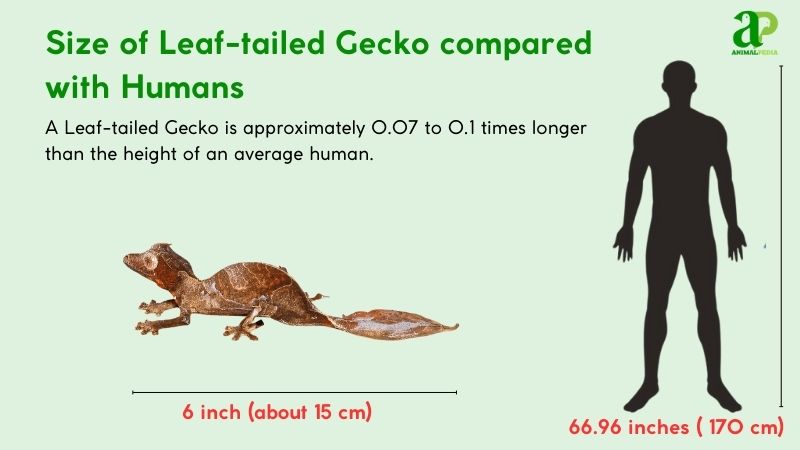
This gecko’s small stature, comparable to the length of a human thumb, is a key component of its specialized camouflage, allowing it to hide effectively among forest debris. Their small size is perfect for hiding in their native habitat. But where exactly do these unique creatures call home?
Where Do Leaf-tailed Geckos Live?
These geckos are endemic to the island of Madagascar, inhabiting the northern and central regions, a geographic exclusivity that underscores their unique evolutionary path [1, 4]. Within this limited range, Uroplatus phantasticus are strictly arboreal and nocturnal, thriving primarily within the humid, undisturbed tropical forests [1]. They prefer the forest understory, where they are found among low-lying shrubs and trees, and at elevations typically ranging between 800 and 1,200 meters [3].

The Leaf-tailed Geckos species’ dependence on these specific forest microhabitats highlights their role as a bioindicator of environmental health. Although they are not considered territorial, their solitary nature and specialized camouflage lead them to remain motionless in the same location for extended periods, only moving to hunt for insects or find a mate at night. Their specific habitat shapes their entire lifestyle. Discover the fascinating daily behaviors that define this elusive species.
How Do Leaf-tailed Geckos Behave?
The Satanic Leaf-tailed Gecko’s behavior is a marvel of evolutionary adaptation, centered on stealth, patience, and a surprising defensive display. This species’s survival in the dense tropical forests of Madagascar depends entirely on its masterful camouflage. The gecko’s behavior perfectly aligns with its habitat and nocturnal lifestyle, ensuring it can hunt and evade predators effectively.
- Diet and Hunting: This gecko is a carnivorous insectivore, using a patient ambush strategy to hunt. It remains motionless until prey is close, then launches a rapid, precise strike to capture it with its continuously replaced teeth.
- Movement and Abilities: The gecko’s movement combines slow, deliberate motions with quick bursts of speed. It uses adhesive toe pads to cling to surfaces and can perform a “cryptic shifting” motion, swaying to mimic a leaf in the wind.
- Daily and Seasonal Patterns: These geckos are strictly nocturnal, with their most active period from dusk until dawn. Their hunting activity peaks during the wet season when insects are abundant.
Their unique physical form directly dictates their survival behaviors. Curious to learn more about how they feed and move? Uncover the secrets of their diet and abilities in the sections that follow.
Diet and Feeding
As carnivorous insectivores, Uroplatus phantasticus primarily consume a variety of small arthropods, with their diet consisting almost entirely of live invertebrates such as crickets, moths, spiders, and roaches [1]. The gecko employs an ambush hunting strategy, remaining motionless on a tree or shrub until prey comes within striking distance, at which point it executes a rapid lunge. Its adhesive toe pads allow it to maintain a secure grip, while its sharp teeth, which are continuously replaced, ensure it can seize and hold its fast-moving prey with high efficiency.
Being strictly nocturnal, these geckos begin their hunting expeditions at dusk and continue throughout the night, acting as solitary feeders to minimize competition for resources within their territory. The specialized nature of their regenerative teeth ensures a perpetual ability to grasp and secure their meals, a crucial adaptation for a predator that relies on a single, precise bite to subdue its prey.

Movement and Abilities
These geckos exhibit a fascinating duality of movement, combining deliberate, slow-paced actions with rapid, explosive bursts of speed. Their primary mode of arboreal locomotion is facilitated by the specialized lamellae on their toe pads, enabling them to cling effortlessly to the vertical and inverted surfaces of leaves and tree trunks [1]. When disturbed, a gecko may perform a subtle cryptic shifting motion, gently swaying to mimic a leaf moving in the breeze, a crucial aspect of its camouflage.
While not built for sustained speed, a gecko can achieve impressive bursts of acceleration when lunging at prey, and their physical capabilities are designed for a rapid, precise strike. Their most remarkable abilities are the voluntary shedding of their tail through autotomy, which serves as a highly effective distraction for predators [2], and their mimicry of swaying foliage, a specialized trait that perfects their disguise in the wild [1].
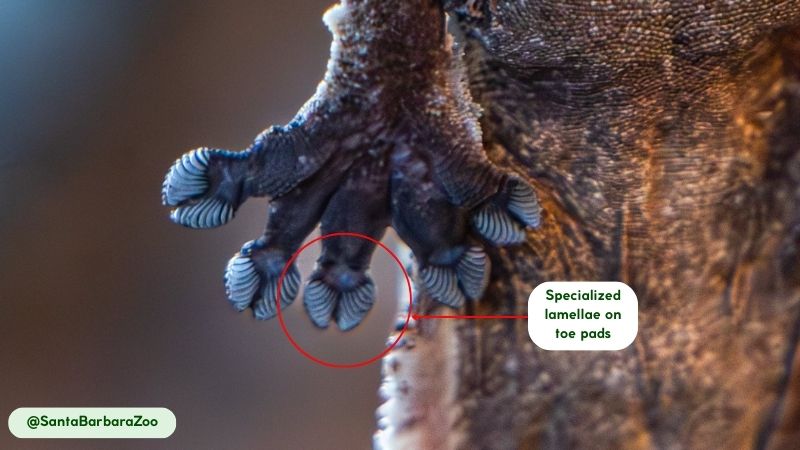
Daily/Seasonal Patterns
Leaf-tailed Gecko are strictly nocturnal, with their active period beginning at dusk and concluding at dawn [1]. Their daily activity cycle is a carefully timed sequence, directly linked to the availability of prey and the avoidance of diurnal predators.
- Dusk (6-7 PM): Emergence from their daytime roosts, where they have been camouflaged, to begin their nighttime routines.
- Night (7 PM – 4 AM): This is their primary period of activity, dedicated to active hunting, foraging for insects, and seeking out potential mates.
- Dawn (4-6 AM): The geckos return to their chosen roosting sites, pressing their bodies against a tree trunk or in foliage to prepare for a day of rest and camouflage.
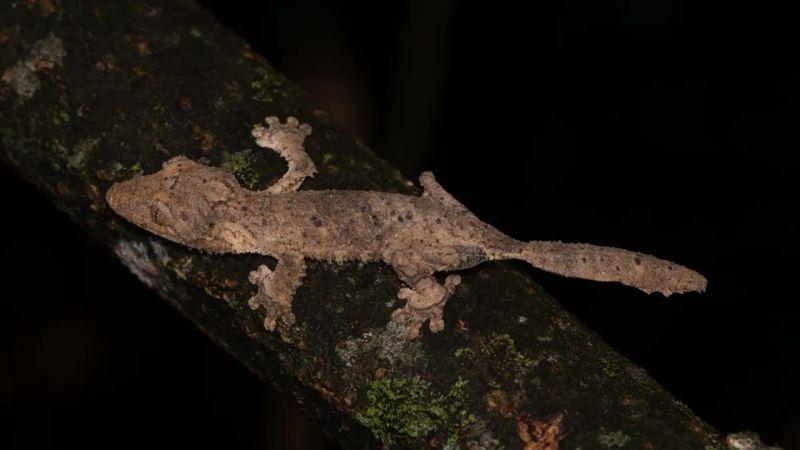
Their activity levels are closely tied to Madagascar’s climate, peaking during the wet season when insect populations are most abundant, and a slight decrease may be observed during the drier periods [1]. As a species that relies on a specific forest microhabitat, they do not exhibit any migratory behavior, instead maintaining a small, localized home range [1]. Reproduction is just one part of their life cycle. Find out how long these mysterious geckos live both in the wild and in captivity.
How Do Leaf-tailed Geckos Reproduce?
Leaf-tailed Geckos are an oviparous species, meaning they reproduce by laying eggs [1]. Mating typically occurs during the wet season, from November to February, a period of increased prey availability and favorable temperatures [1]. Courtship rituals are often subtle, with males using a series of head-bobbing motions and soft vocalizations to attract a mate. Following a successful courtship, the male will grasp the female’s neck with his mouth during copulation.
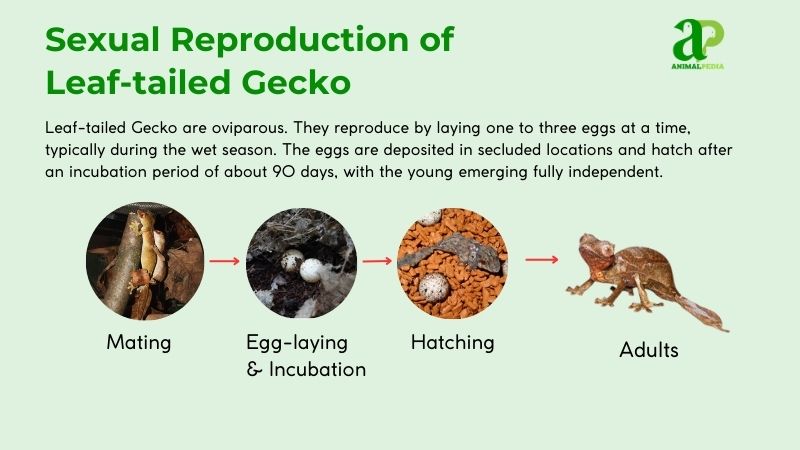
After mating, a female will lay clutches of one to three eggs, with clutch size often correlating to her overall body condition and age [1]. The eggs, which are soft and pliable when laid, harden over a period of 24 hours. They are typically deposited in a secluded location, such as under decaying leaf litter or in the crevices of tree bark, to ensure protection from predators and environmental fluctuations [1]. The incubation period lasts approximately 90 days, with hatchlings emerging fully formed and independent, as there is no parental care after the eggs are laid [1]. With their secretive lives and specialized roles, it’s natural to wonder about their impact on the broader ecosystem. Are these geckos beneficial to humans?
How Long Do Leaf-tailed Geckos Live?
A Leaf-tailed Gecko’s lifespan varies significantly depending on its environment; in the wild, it lives an average of 5 to 8 years, while under ideal captive care, it can live for over a decade [1, 4]. A key factor influencing their longevity is their sexual maturity, which is reached around 9 to 12 months of age, allowing them a relatively short window of time for breeding in their native habitat. In the wild, their survival is largely determined by factors such as habitat quality and predation pressure, as well as the human impact of habitat degradation and illegal collection.
Conversely, a controlled captive environment mitigates these threats, providing consistent nutrition and protection from predators, which directly contributes to a longer, healthier life. While they contribute to a healthy ecosystem, their existence faces modern threats. Find out about their current conservation status.
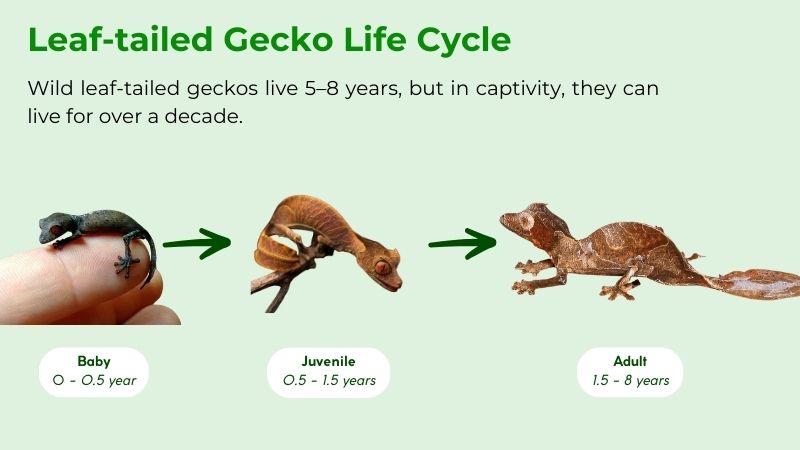
In the wild, a leaf-tailed gecko lives for 5 to 8 years
Are Leaf-tailed Geckos Beneficial to Humans?
Leaf-tailed Geckos are beneficial to humans. As an arboreal insectivore, the species plays a significant ecological role in controlling populations of various arthropods within its native habitat, including potential pests like roaches and spiders [1]. They are a non-venomous species and do not pose a threat to human health through bites, as their small, sharp teeth are designed for grasping insect prey, not for a defensive bite against a larger organism.
When threatened, these geckos will engage in a harmless defensive display, opening their bright red mouths wide and issuing a distress call to startle perceived threats. This behavior is a bluff, not an act of aggression. Thus, their primary interaction with humans is beneficial, as they contribute to a healthy, balanced forest ecosystem. Beyond their conservation status, these geckos hold a surprising number of records and fascinating traits. Prepare to be amazed by some little-known facts about this incredible species.
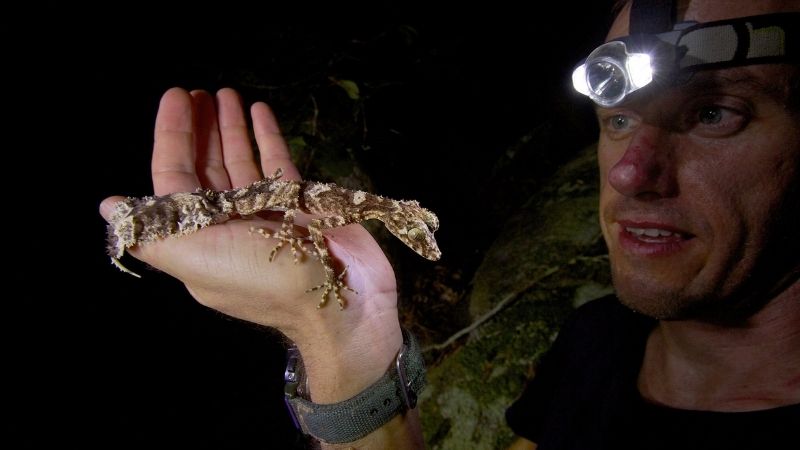
Are Leaf-tailed Geckos Endangered?
According to the IUCN, the Satanic Leaf-tailed Gecko (Uroplatus phantasticus) is currently classified as a species of Least Concern (LC) [2]. This designation indicates that the species does not face an imminent risk of extinction, however, this status is not static. The primary threats to the species’ long-term survival include habitat degradation and loss due to deforestation, as well as illegal collection for the exotic pet trade [2]. As a crucial bioindicator, the health of Uroplatus phantasticus populations directly reflects the ecological integrity of their forest habitats; a decline in their numbers often signals broader environmental issues.
To ensure the continued survival of this species, individual conservation actions are vital. Supporting accredited conservation organizations that work to protect Madagascar’s forests is a highly effective way to help, as these efforts contribute to safeguarding the geckos’ natural habitat. Additionally, advocating for and engaging in responsible pet ownership practices, which includes only acquiring geckos from reputable breeders who can verify captive-bred origins, helps to reduce the demand for illegally collected specimens. Through these combined efforts, we can contribute to the long-term protection of these remarkable creatures and their fragile ecosystems.

Frequently Asked Questions About Leaf-tailed Geckos
Do Satanic Leaf Tailed Geckos Have Wings?
No, Satanic Leaf-tailed Geckos do not have wings. As a reptile of the order Squamata, their arboreal movement relies entirely on their specialized toe pads, which enable them to climb and cling to surfaces with exceptional grip rather than flying.
Are Leaf Tailed Geckos Poisonous?
No, leaf-tailed geckos are not poisonous. They are a completely harmless and non-venomous species. When threatened, they engage in a bluffing display by opening their bright red mouths to startle a predator, but they pose no danger to humans.
Can Leaf Tailed Geckos Change Colors?
Yes, leaf-tailed geckos can change colors. While not as dramatic as a chameleon, they are able to subtly alter their mottled skin tone to better match their immediate surroundings, whether shifting to a lighter or darker shade to enhance their camouflage.
Do Leaf Tailed Geckos Live In Groups?
No, leaf-tailed geckos do not live in groups. This species is solitary and highly territorial, interacting with other geckos only during the mating season to find a partner and reproduce.
How Fast Does Satanic Leaf Tailed Geckos Go?
Satanic Leaf-tailed Geckos are not built for speed. They are slow and deliberate movers, relying on their masterful camouflage and patience to ambush prey. Their speed is limited to a single, rapid lunge when striking at an insect.
Conclusion
The Satanic Leaf-tailed Gecko is a testament to the marvel of evolutionary adaptation, a creature that has perfected the art of camouflage to thrive in Madagascar’s unique forests. From its deceptive appearance to its specific behavioral patterns, every aspect of this gecko’s life is a fascinating study in survival.
At Animal-pedia.org, our mission is to bring these incredible stories to you, synthesizing expert zoological knowledge into an engaging, accessible format. We invite you to continue your journey into the animal kingdom. Explore our extensive digital encyclopedia to uncover more about Earth’s diverse fauna and contribute to a deeper understanding of our planet’s wild inhabitants.




